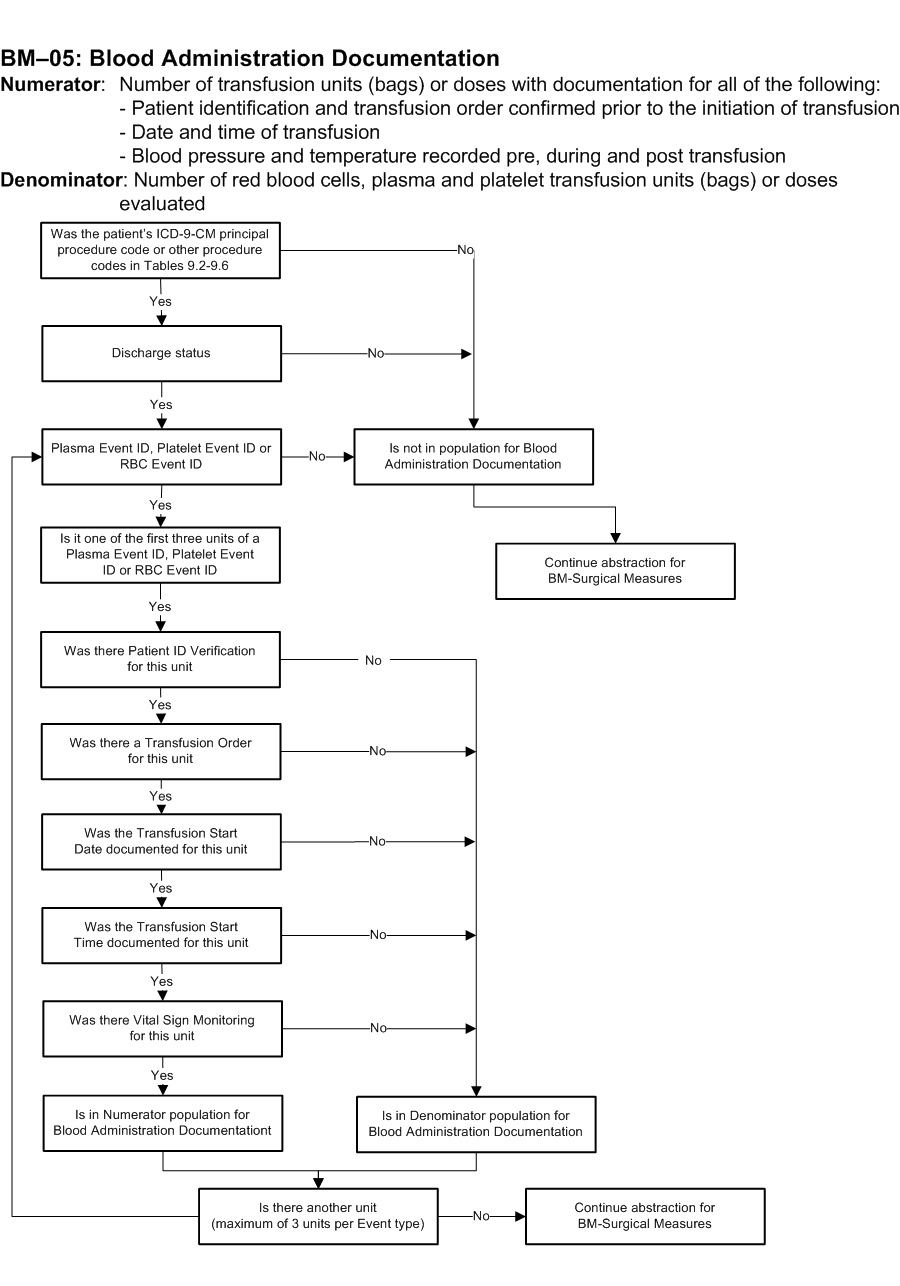Release Notes:
Measure Information Form
Version 2010B
Measure Information Form
Measure Set: Blood Management(BM)
Set Measure ID: BM-05
Performance Measure Name: Blood Administration Documentation
Description: The total number of red blood cells, plasma or platelet transfusion units (bags) or doses that had documentation of the following: patient identification; an order to transfuse confirmed prior to the initiation of transfusion; date and time of transfusion; blood pressure and temperature recorded at specific intervals.
Rationale: Since the majority of blood units are transfused in hospitals, specific policies and procedures have been developed by each hospital to address documentation of blood administration standards in accordance with their state and federal regulations. Though documentation components vary among organizations, identification of the patient and confirmation of the order to transfuse are common indicators used for all blood products since incomplete patient identification could result in an adverse outcome. Prior to administering blood or blood products, patient identification by two identifiers is required by numerous organizations including the AABB Standard 5.19.3, and the Joint Commission National Patient Safety Goal (NPSG) 1. In addition, numerous organizations require or advise that the licensed staff confirm that there is a transfusion order as directed by the AABB Standard 5.19.6 and the elements of performance for the Joint Commission NPSG.01.01.01.
Patient monitoring during the transfusion is an important component related to patient safety. The first 10 to 15 minutes of the transfusion are considered the most critical to assess for a potential transfusion reaction and close observation during this time is recommended in the AABB Primer. Monitoring of vital signs at baseline, during and at the completion of the transfusion in addition to observation are used to assess the patient’s condition for any changes.
Type of Measure: Process
Improvement Noted As: Increase in the rate
Numerator Statement: Number of transfusion units (bags) or doses with documentation for all of the following:
- patient identification and transfusion order confirmed prior to the initiation of transfusion
- date and time of transfusion
- blood pressure and temperature recorded pre, during and post transfusion
Included Populations: Not applicable
Excluded Populations: None
Data Elements:
Denominator Statement: Number of red blood cells, plasma or platelet transfusion units (bags) or doses evaluated
Included Populations:
- Discharges with an ICD-9-CM Principal or Other Procedure Codes for transfusion as defined in Appendix A, Table 9.2-9.6.
- Patients with transfusion of red blood cells, plasma or platelets after hospital arrival.
Excluded Populations:
- Patients less than 4 months of age
Data Elements:
Continuous Variable Statement:
Included Populations:
Excluded Populations:
Data Elements:
Risk Adjustment: No.
Data Collection Approach: Retrospective data collection sources for required data elements include administrative data and medical records. If ICD-9-CM codes are not present, alternative methods of identifying patients who received blood transfusion may be required.
Data Accuracy: Variation may exist in the assignment of ICD-9-CM codes; therefore, coding practices may require evaluation to ensure consistency
Measure Analysis Suggestions: The data from this measure may be used to evaluate the adherence to organizational policies and procedures for blood administration for each of the blood products. Data could be evaluated by unit or service in order to identify areas for staff education. The data could also be used during accreditation surveys to document the hospital’s efforts to improve the accuracy of patient identification when administering blood related to the Joint Commission NPSG 01.01.01.
Sampling: Yes. For additional information see the Population and Sampling Specifications.
Data Reported As: Aggregate rate generated from count data reported as a proportion.
Selected References:
- Whitsett CF, Robichaux MG. Assessment of blood administration procedures: problems identified by direct observation and administrative incident reporting. Transfusion. 2001;41:581-86.
- Saxena S, Ramer L, Shulman IA. A comprehensive assessment program to improve blood-administering practices using the FOCUS-PDCA model. Transfusion. 2004; 44:1350-56.
- Novis DA, Miller KA, Howanitz PJ, Renner SW, Walsh MK; College of American Pathologists. Audit of transfusion procedures in 660 hospitals. A College of American Pathologists Q–Probes study of patient identification and vital sign monitoring frequencies in 16494 transfusions. Arch Pathol Lab Med. 2003;127:541-8.
- Roback JD, ed. Technical manual. 16th ed, Bethseda, MD: AABB, 2008.
- The Joint Commission: Comprehensive Accreditation Manual for Hospitals, 2009. Oakbrook Terrace, IL; Joint Commission Resources, Inc., 2009.
- The Joint Commission, “National Patient Safety Goals (NPSG)”, IN: Comprehensive accreditation manual for hospitals, 2009. Oakbrook Terrace, IL; Joint Commission Resources, Inc., 2009, pp. NPSG 1 – NPSG 4.
- AABB Primer of Blood Administration. Revised August 2008. Bethseda, Maryland. [Available at http://www.aabb.org/Content/Professional_Development/Education_and_Training_Material/edtrain.htm#2 (accessed November 2009).]
Measure Algorithm:

 Attach file
Attach file

 Attach file
Attach file